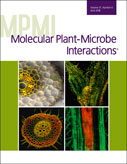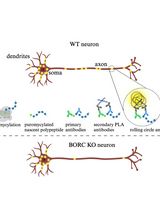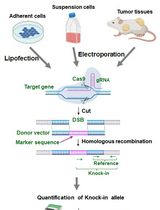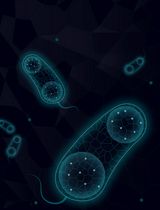- EN - English
- CN - 中文
Histological Methods to Detect Early-stage Plant Defense Responses during Artificial Inoculation of Lolium perenne with Epichloë festucae
羊茅人工接种多年生黑麦草过程中植物早期防御反应的组织学检测
发布: 2021年05月05日第11卷第9期 DOI: 10.21769/BioProtoc.4013 浏览次数: 6963
评审: Xiaofei LiangShweta PanchalSatyabrata Nanda
Abstract
Epichloë species form agriculturally important symbioses with many cool season grasses. To study these symbioses, such as the interaction of Epichloë festucae with perennial ryegrass (Lolium perenne), host plants can be infected by artificial inoculation of etiolated seedlings. This inoculation is performed by placing mycelium into an incision in the meristem, as previously described by Latch and Christensen (1985). In recent years, this method has been broadly used to study this interaction at the molecular level using different Epichloë festucae mutants that can cause incompatible interactions. We have developed and adapted methods to study four of the most important host plant responses to infection, including cell death, callose deposition, lignin production, and hydrogen peroxide (H2O2) production, which are useful in defining the host response to infection at a very early time point.
Keywords: Endophytic fungi (内生真菌)Background
Although artificial inoculation of perennial ryegrass (Lolium perenne) is broadly used to study its interaction with Epichloë festucae, there exists no comprehensive protocol for the evaluation of responses to fungal infection at an early post-inoculation time point, which likely defines the future of this interaction. In our recent work (Rahnama et al., 2018), we adapted methods to study four of the most important host plant responses during plant-fungal interactions including cell death, callose deposition, lignin production, and hydrogen peroxide (H2O2) production.
In response to invading microbes, one of the early plant actions is the production of different types of reactive oxygen species (ROS), including H2O2, which act as an antimicrobial agent to protect the plant against invading microbes and are one of the first signals to induce other plant responses (Walters, 2003). In addition, by depositing callose and lignin, plants remodel their cell wall at the infection site to stop invading fungi (Luna Diez et al., 2010; Zipfel, 2009). As a late defense response, plant cells surrounding the infection site undergo programmed cell death (hypersensitive response) to limit available food for the invading microbe (Lo Presti et al., 2015). To initiate and maintain a successful symbiotic lifestyle, Epichloë endophytes must somehow suppress or avoid these different host defense responses; although, very little is known about how this occurs. Developing methods to detect these responses will aid in the understanding of this system, especially when applied to the study of mutant strains that compromise symbiosis.
To stain for callose deposition, we adapted an Aniline Blue staining method (Knox, 1979) that was originally used for the detection of callose in pollen tubes but has also been used in different fungal-plant interactions such as powdery mildew infection of Arabidopsis (Ellinger et al., 2013). Besides aniline blue, Toluidine Blue O has also been used in other systems such as guava root infection with Fusarium (Gupta et al., 2012). In addition to staining methods, there exist non-staining methods using immunofluorescence that detect callose at the micro-level in internal cell sites such as plasmodesmata (Pendle and Benitez-Alfonso, 2015).
To detect lignin deposition, we used a Safranin solution adapted from a study on maize infection by Ustilago maydis (Tanaka et al., 2014); however, Safranin is broadly used in other systems such as Fusarium infection of different cereals (Knight et al., 2011). Moreover, the Wiesner (phloroglucinol-HCl) reaction (Pomar et al., 2002) is another method to study lignin deposition in plant-fungal interactions.
To visualize cell death responses, Trypan Blue staining is the most widely used method, for which we adapted the protocol used to study Arabidopsis infection with downy mildew (Koch and Slusarenko, 1990). Recently, a non-toxic method has also been suggested, which uses red light imaging (Landeo Villanueva et al., 2021).
There are several methods to detect H2O2, one of the basic methods for which is the detection of the oxidization of small molecules, which we also used here. This method is based on visualizing the color change of 3,3’-diaminobenzidine (DAB) after being oxidized by H2O2. We adapted this method from a study on barley infection with powdery mildew (Thordal-Christensen et al., 1997). Other recent methods to study H2O2 have used genetically encoded green fluorescent protein (GFP)-based probes that react directly with H2O2 (reviewed in Winterbourn, 2018).
Here, we demonstrate that these methods are useful for defining the response of perennial ryegrass to infection with Epichloë endophyte at a very early time point. Using these methods in time-point studies, we defined the most suitable time to measure these responses post-inoculation. As such, these methods are useful for studying compatible and incompatible interactions of symbiotic fungi with their host plants during the early stages of infection (Rahnama et al., 2018 and 2019). Although these methods are routinely used for other fungal-plant interactions, our adaption of them to study the early inoculation stages of Epichloë-grass interactions is novel. These methods can be used in other grass-endophyte interactions that use a similar inoculation technique.
Materials and Reagents
1.5 ml Pierce microcentrifuge tubes (Thermo Scientific, catalog number: 69715)
Petri dishes (Fisher brand, Fisher Scientific, catalog number: FB0875712)
Microscope slides (Pearl, catalog number: 7101)
Microscope slide coverslips (Pearl)
1 ml Sterilin plastic transfer pipettes (Thermo Scientific, catalog number: 201C)
Surgical blade No.11 for metal scalpel 10621 (Feather, catalog number: 2976)
Household aluminum foil
Root trainers (Flight Plastic Ltd.)
Grass seeds (used here: Lolium perenne cv Samson seeds, endophyte-free; Agricom, New Zealand)
An Epichloë strain, E. festucae Fl1 (ATCC, catalog number: MYA-3407)
Autoclaved distilled water
Technical grade agar (Difco Laboratories, catalog number: DF0812-17-9)
Potato dextrose broth (Difco Laboratories, catalog number: DF0549-17-9)
L-lactate hydrate (C3H6O3) (Sigma-Aldrich, catalog number: L1750)
Glycerol (HOCH2CH(OH)CH2OH) (Sigma-Aldrich, catalog number: G9012)
Phenol (C6H5OH) (Thermo Scientific, catalog number: 17914)
Trypan Blue (C34H24N6O14S4Na4) (Sigma-Aldrich, catalog number: T6146)
Chloral hydrate (Cl3CCH(OH)2) (Sigma-Aldrich, catalog number: C8383)
Aniline Blue W.S. (C32H25N3Na2O9S3) (Sigma-Aldrich, catalog number: 28631-66-5)
Tripotassium orthophosphate (K3PO4) (VWR, catalog number: 700001)
Safranin O (C.I. 50240) (C20H19ClN4) (Sigma-Aldrich, catalog number: 1159480025)
3,3’-Diaminobenzidine (DAB) (Sigma-Aldrich, catalog number: D12384)
Hydrochloric acid (HCL) (Sigma-Aldrich, catalog number: D12384)
95% Ethanol (CH3CH2OH) (Sigma-Aldrich, catalog number: 11727)
Sucrose (Sigma-Aldrich, catalog number: S8501)
Boric acid (BH3O3) (Thermo Scientific, catalog number: AC315185000)
2.4% Potato dextrose agar (see Recipes)
3% Water agar (see Recipes)
Lactophenol-Trypan Blue solution (see Recipes)
Chloral hydrate solution (see Recipes)
Aniline Blue solution (see Recipes)
Pollen germination slides (see Recipes)
Safranin solution (see Recipes)
DAB solution (see Recipes)
Equipment
100 ml glass beaker
Leica DMR microscope (camera: Leica DC500)
Autoclave
Fridge
Laminar flow cabinet
Incubator (Thermo Scientific, 3110 CO2 Water-Jacketed Incubator)
Stereomicroscope (Leica, model: Leica M3Z)
Precellys 24 tissue disruptor (Bertin Technologies)
Stainless-steel forceps (Sigma-Aldrich, catalog number: Z168777)
Metal scalpel (Sigma-Aldrich, catalog number: S2646)
Procedure
文章信息
版权信息
© 2021 The Authors; exclusive licensee Bio-protocol LLC.
如何引用
Rahnama, M., Fleetwood, D. J. and Johnson, R. D. (2021). Histological Methods to Detect Early-stage Plant Defense Responses during Artificial Inoculation of Lolium perenne with Epichloë festucae. Bio-protocol 11(9): e4013. DOI: 10.21769/BioProtoc.4013.
分类
植物科学 > 植物生物化学
微生物学 > 微生物-宿主相互作用
生物化学 > 其它化合物 > 木质素
您对这篇实验方法有问题吗?
在此处发布您的问题,我们将邀请本文作者来回答。同时,我们会将您的问题发布到Bio-protocol Exchange,以便寻求社区成员的帮助。
Share
Bluesky
X
Copy link













